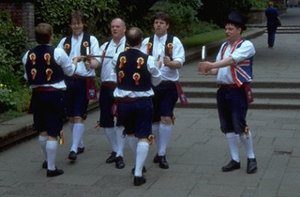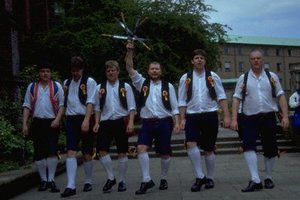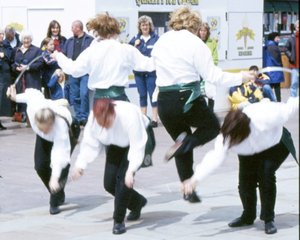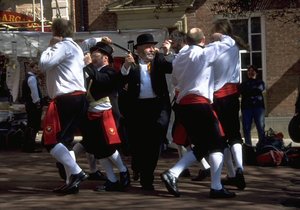Rapper sword
|
|
| North East |
|---|
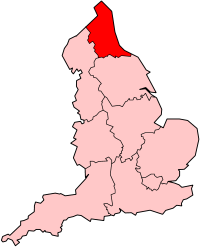
|
Rapper sword is a kind of sword dance.
| Contents |
History
The rapper sword tradition (which has no connection with rapping) was traditionally performed in the mining villages of the Northumberland and Durham coalfield in North East England, especially in Tyneside. The dance involves five people (often accompanied by two Tommy and Betty characters) connected by short, two-handled, flexible swords (called rappers) forming an unbroken chain. The dance is related to the Long Sword dance of Yorkshire, as well as other sword dances in Europe.
The dance is a fairly rapid one, performed at around 100-160 beats per minute, with different team styles using different rates. It should nonetheless be performed in a smooth and graceful manner, with one figure flowing seamlessly into the next. A number of acrobatic figures can be employed, including forward and backward somersaults over swords held at waist height. It is beyond reasonable dispute that rapper is the most exciting of England's traditional dances to watch.
The dance is now almost always performed to jigs (6/8 time), and indeed the normal form of rapper "stepping" – a form of shuffle imported in the 1920s from the local clog dance tradition – would not be possible if a jig were not used. However, some of the earliest teams used hornpipes rather than jigs. The jigs used include local tunes, although most rapper jigs used for at least the last hundred years are Irish tunes, probably imported by Irish immigrants to Tyneside in the nineteenth century. Many instruments can and have been used to accompany rapper dances, the most popular being fiddles, tin whistles and accordions. The music is usually performed solo, although can be performed as a duet; however, rapper is not usually performed to a band.
Earsdon_1910.jpg
The costume in which the dance is usually performed is a stylized version of the working clothes of the local nineteeth century coal miner (see photograph, left). It consists of shirt, sash, pit hoggers (a type of knee-length trousers, similar to breeches but open at the knee to be practical for working in the confined spaces of coal mines) and socks or stockings. Some traditional teams decorated their kit with ribbons or rosettes, and added a tie and/or waistcoat; long trousers can be used in place of hoggers, as for example by the Swalwell dancers.
Modern teams use a variety of kits, mostly based on the traditional costume, with each team using different combinations of colours to try to have a unique corporate image. Some other modern sides, especially women's sides, use very different kits.
An article reviewing the kits used by traditional sides was published in The NUT and is available in the Archives section of The NUT on the Net website.
Based on early historical records, the dance would appear to be derived from an older tradition using rigid swords – like the Long Sword dance. At some stage in the nineteenth century, these rigid swords were replaced by flexible rappers. This major development in the tradition may have been entirely accidental – perhaps someone tried to improvise a sword using a flexible length of steel (such as a saw blade with the teeth filed down), and in a moment of inspiration realised the potential of using flexible swords. Teams were certainly known to have improvised rappers from mining tools such as saw blades and bed laths; and in any case, purpose-made flexible rappers would have been prohibitively expensive before the invention of the Bessemer process in 1855 allowed steel to be made inexpensively.
During the nineteenth century, teams of rapper dancers from the pit villages of Tyneside, and later Wearside, would travel annually to the towns of Newcastle_upon_Tyne, Sunderland and Durham to peform the dance for the crowds – and for a consideration in money! This was later revived as a source of income during the miners' strikes and lay-offs of the Great Depression.
By the early twentieth century, the tradition was beginning to die out, but was revived by the interest generated after Cecil Sharp published notations for five of the traditional village dances in his book, The Sword Dances of Northern England. After the First World War, the revival was marked by the fierce competition between pit villages in the rapper classes of the newly-instituted North of England Musical Tournament held annually in Newcastle upon Tyne.
After the Second World War, the tradition progressively declined in its original pit villages, partly as a result of social changes in the mining communities. However, another revival was initiated after the war by students at Kings College in Newcastle upon Tyne (now the University of Newcastle upon Tyne), which subsequently spread beyond the traditional area. Revival teams worldwide now perform the tradition, sometimes learnt from published notations, sometimes taught by rapper dancers in what is almost a continuation of the earlier oral traditions.
Further information
Further information is provided by the Rapper Online Web site, including the origins and history of the dance, teams listing, notations of traditional dances and more. Current and historical information is also available at The NUT on the Net – the Web edition of The NUT, the journal of the rapper sword dance.
Leading exponents of the tradition in its traditional area include the Newcastle Kingsmen and High Spen Blue Diamonds. The Rapper Online website provides the definitive list of rapper sword teams.
A competition, known as DERT (Dancing England Rapper Tournament), which is open to all rapper sword teams is held annually. In March 2005 DERT20005 was held in Preston, Lancashire.
Images
The images below show some examples of Rapper sword dancing, taken from the Newcastle Kingsmen and World Millennium Sword Spectacular Web sites.
Missing image Quadrap1.jpg The Newcastle Kingsmen displaying the "Haymarket" figure | |
Missing image Jack_the_rapper2.jpg Jack the Rapper - a rapper team from Norway! |
External Links
- Rapper Online (http://www.rapper.org.uk/)
- History of rapper (http://www.rapper.org.uk/history.html)
- The NUT on the Net (http://www.the-nut.net/)
- Newcastle Kingsmen (http://www.kingsmen.co.uk/)
- High Spen Blue Diamonds (http://www.highspen.org.uk/)
- DERT 2004 (http://myweb.tiscali.co.uk/dert2004/)
- DERT 2005 (http://www.dert2005.org.uk/)
- World Millennium Sword Spectacular (http://www.swordspectacular.org/swordspec2000/)
Updating the Rapper Sword Pages
This section provides a view of Rapper Sword from the perspective of members of the Newcastle Kingsmen. Members of other rapper sword teams are invited to contribute to the pages. Please read the Discuss This Page (http://en.wikipedia.org/wiki/Talk:Rapper_sword) section so that the pages will continue to provide a readable, useful and authoratitive view of Rapper Sword dancing as new material is added.de:Rapper Sword

